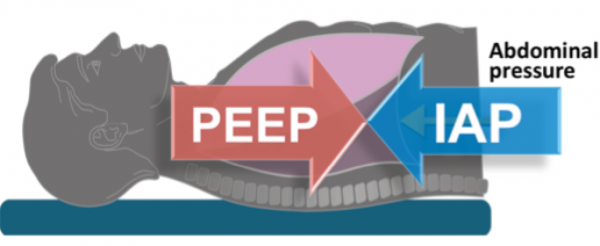
How to set PEEP in Abdominal Hypertension
How Intra-Abdominal Pressure affects respiratory mechanics and how to set PEEP in intra-abdominal hypertension
Increased intra-abdominal pressure (IAP) alters PV curves and usually shifts the chest wall PV loop to the right while lung PV curves remain unaffected.
The application of PEEP will increase IAP but only when > 10 cmH2O
On average a PEEP 15 cmH2O → IAP + 1.5mmHg
Animal DATA
- study in 13 pigs, healthy lungs, IAH with inflatable balloon, unmatched PEEP
Conclusion:- PEEP below IAP level cannot prevent FRC decline
- IAP of 18 mmHg = 25 cm H2O!
- study in 9 pigs, healthy lungs, IAH with inflatable balloon, matched PEEP
Conclusion:- preservation of end-expiratory lung volume
- No improvement in arterial oxygen tension
- reduction in cardiac output
- study in 8 pigs, IAH 20 mmHg, ALI lavage
Conclusion:- Lower LIP (shifting of PV curve to right + flattening)
- Better compliance
- Lower D(A-a)O2 (less shunt)
- study in 9 pigs, oleic acid (OA) induced lung injury, IAH with inflatable balloon
Conclusion:- Better EELV
- Lower shunt
- Lower deadspace
- Better P/F ratio
- Human data 20 patients with ALI/ARDS with normal IAP or IAH treated in the surgical intensive care unit
Conclusion:- No difference in oxygenation
- Decreased elastance of the respiratory system and the lung at PEEP 15
- EVLWI was lower in ALI/ARDS patients with IAH and high PEEP
- Small numbers : only 2x 10 patients (underpowered)
- Relatively low values of IAP (16 vs 8 mmHg)
- No real matching between PEEP and IAP
Take Home messages
with regard to ventilator setting in patients with ALI/ARDS and abdominal hypertension
- Measure IAP and Peso + CO monitoring!
- Think of the polycompartment syndrome
- Avoid HOB > 45° in high BMI
- Calculate ATI and TAI
- Lung (Paw) vs Thorax (Ppl) vs Filling pressures (CVP)
- Use higher opening pressures for recruitment
- Not 40-by-40 but (40+IAP/2)-by-40 manoever
- Use higher TV (10ml/kg)?
- Use higher PEEP to keep lung open
- Best PEEP (cmH20) = (LIP + 2) = IAP (mmHg)
- Monitor hemodynamics
- Measure EVLWI and PVPI
- Deep sedation + try short course of NMB
- Body positioning!
- Use anti-Trendelenburg position
- abdominal suspension when PRONE
- Lung protective ventilation